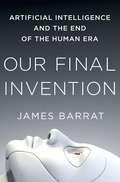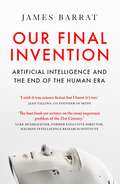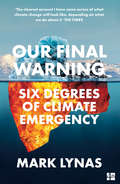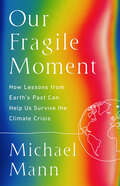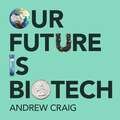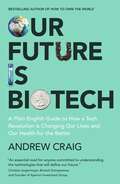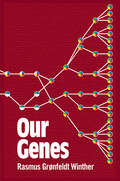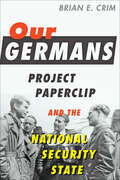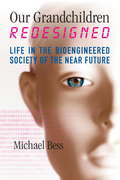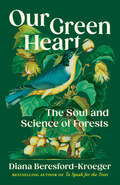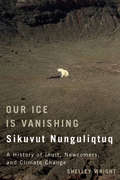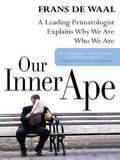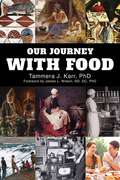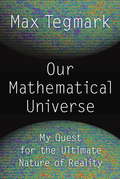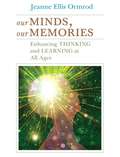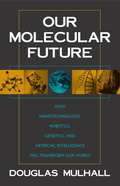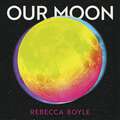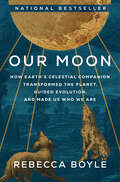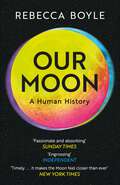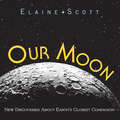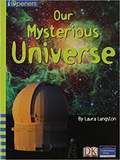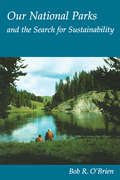- Table View
- List View
Our Final Invention: Artificial Intelligence and the End of the Human Era
by James Barrat[from inside flaps] "ARTIFICIAL INTELLIGENCE helps choose what books you buy, what movies you see, and even who you date. It puts the "smart" in your smartphone and soon it will drive your car. It makes most of the trades on Wall Street, and controls vital energy, water, and transportation infrastructure. But Artificial Intelligence can also threaten our existence. In as little as a decade, AI could match and then surpass human intelligence. Corporations and government agencies are pouring billions into achieving AI's Holy Grail--human-level intelligence. Once AI has attained it, scientists argue, it will have survival drives much like our own. We may be forced to compete with a rival more cunning, more powerful, and more alien than we can imagine. Through profiles of tech visionaries, industry watchdogs, and groundbreaking AI systems, Our Final Invention explores the perils of the heedless pursuit of advanced AI. Until now, human intelligence has had no rival. Can we coexist with beings whose intelligence dwarfs our own? And will they allow us to?"
Our Final Invention: Artificial Intelligence and the End of the Human Era
by James Barrat'I wish it was science fiction, but I know it's not.' Jaan Tallinn, co-founder of Skype'If you read just one book that makes you confront scary high-tech realities that we'll soon have no choice but to address, make it this one.' Washington Post Corporations and government agencies around the world have for years been pouring billions into achieving AI's Holy Grail - human-level intelligence. But once AI has attained it, scientists argue, it will have survival drives much like our own. We may be forced to compete with a rival more cunning, more powerful, and more alien than we can imagine.First published ten years ago, Our Final Invention predicted much of the artificial 'intelligence explosion' that is now ripping through our culture, and was named by Elon Musk as one of five books everyone should read about the future. Now with an urgent new preface, James Barrat's landmark work explores the ethics, history and future perils of the heedless pursuit of advanced AI. Until now, human intelligence has had no rival. Can we coexist with beings whose intelligence dwarfs our own? And will they allow us to?
Our Final Warning: Six Degrees of Climate Emergency
by Mark LynasWe are living in a climate emergency. But how much worse could it get? Will civilization collapse? Are we already past the point of no return? What kind of future can our children expect? Rigorously cataloguing the very latest climate science, Mark Lynas explores the course we have set for Earth over the next century and beyond. Degree by terrifying degree, he charts the likely consequences of global heating and the ensuing climate catastrophe. <P><P> At one degree – the world we are already living in – vast wildfires scorch California and Australia, while monster hurricanes devastate coastal cities. At two degrees the Arctic ice cap melts away, and coral reefs disappear from the tropics. At three, the world begins to run out of food, threatening millions with starvation. At four, large areas of the globe are too hot for human habitation, erasing entire nations and turning billions into climate refugees. At five, the planet is warmer than for 55 million years, while at six degrees a mass extinction of unparalleled proportions sweeps the planet, even raising the threat of the end of all life on Earth. <P><P> These escalating consequences can still be avoided, but time is running out. We must largely stop burning fossil fuels within a decade if we are to save the coral reefs and the Arctic. If we fail, then we risk crossing tipping points that could push global climate chaos out of humanity’s control. <P><P> This book must not be ignored. It really is our final warning.
Our Fragile Moment: How Lessons from Earth's Past Can Help Us Survive the Climate Crisis
by Michael E. MannIn this sweeping work of science and history, the renowned climate scientist and author of The New Climate War shows us the conditions on Earth that allowed humans not only to exist but thrive, and how they are imperiled if we veer off course. For the vast majority of its 4.54 billion years, Earth has proven it can manage just fine without human beings. Then came the first proto-humans, who emerged just a little more than 2 million years ago—a fleeting moment in geological time. What is it that made this benevolent moment of ours possible? Ironically, it&’s the very same thing that now threatens us—climate change. The drying of the tropics during the Pleistocene period created a niche for early hominids, who could hunt prey as forests gave way to savannahs in the African tropics. The sudden cooling episode known as the &“Younger Dryas&” 13,000 years ago, which occurred just as Earth was thawing out of the last Ice Age, spurred the development of agriculture in the fertile crescent. The &“Little Ice Age&” cooling of the 16th-19th centuries led to famines and pestilence for much of Europe, yet it was a boon for the Dutch, who were able to take advantage of stronger winds to shorten their ocean voyages. The conditions that allowed humans to live on this earth are fragile, incredibly so. Climate variability has at times created new niches that humans or their ancestors could potentially exploit, and challenges that at times have spurred innovation. But there&’s a relatively narrow envelope of climate variability within which human civilization remains viable. And our survival depends on conditions remaining within that range. In this book, renowned climate scientist Michael Mann will arm readers with the knowledge necessary to appreciate the gravity of the unfolding climate crisis, while emboldening them—and others--to act before it truly does become too late.
Our Future is Biotech: A Plain English Guide to How a Tech Revolution is Changing Our Lives and Our Health for the Better
by Andrew Craig"An essential read for anyone committed to understanding the technologies that will define our future." CHRISTIAN ANGERMAYER, BIOTECH ENTREPRENEUR AND FOUNDER OF APEIRON INVESTMENT GROUPWelcome to the biotech revolutionIn the last century, technology has transformed the human experience across the world. This has been super-charged by the arrival of the internet, smart phones, AI and machine learning, and created trillion-plus dollar companies and household names like Apple, Amazon, Google and Microsoft.Our Future is Biotech explains why biotech is next: because our biggest remaining challenges as a species concern biological systems.Biotech companies will solve our most intractable problems, from cancer, dementia, obesity and diabetes to elderly care, mental health conditions, and even clean power generation, agricultural production and environmental degradation.Biotech means that we can all live better, safer, healthier, wealthier, happier, and longer lives.The industry has already delivered "miracle cures" for several diseases, and there is more to come. But despite this, few people are aware of the phenomenal progress being made. Our Future is Biotech addresses this, explaining what biotech is, what is coming next, and how you might profit from it too.Tech has been the most important theme for human progress for the last century. Biotech is next.
Our Future is Biotech: A Plain English Guide to How a Tech Revolution is Changing Our Lives and Our Health for the Better
by Andrew Craig"An essential read for anyone committed to understanding the technologies that will define our future." CHRISTIAN ANGERMAYER, BIOTECH ENTREPRENEUR AND FOUNDER OF APEIRON INVESTMENT GROUPWelcome to the biotech revolutionIn the last century, technology has transformed the human experience across the world. This has been super-charged by the arrival of the internet, smart phones, AI and machine learning, and created trillion-plus dollar companies and household names like Apple, Amazon, Google and Microsoft.Our Future is Biotech explains why biotech is next: because our biggest remaining challenges as a species concern biological systems.Biotech companies will solve our most intractable problems, from cancer, dementia, obesity and diabetes to elderly care, mental health conditions, and even clean power generation, agricultural production and environmental degradation.Biotech means that we can all live better, safer, healthier, wealthier, happier, and longer lives.The industry has already delivered "miracle cures" for several diseases, and there is more to come. But despite this, few people are aware of the phenomenal progress being made. Our Future is Biotech addresses this, explaining what biotech is, what is coming next, and how you might profit from it too.Tech has been the most important theme for human progress for the last century. Biotech is next.
Our Future is Biotech: A Plain English Guide to How a Tech Revolution is Changing Our Lives and Our Health for the Better
by Andrew Craig"An essential read for anyone committed to understanding the technologies that will define our future." CHRISTIAN ANGERMAYER, BIOTECH ENTREPRENEUR AND FOUNDER OF APEIRON INVESTMENT GROUPWelcome to the biotech revolutionIn the last century, technology has transformed the human experience across the world. This has been super-charged by the arrival of the internet, smart phones, AI and machine learning, and created trillion-plus dollar companies and household names like Apple, Amazon, Google and Microsoft.Our Future is Biotech explains why biotech is next: because our biggest remaining challenges as a species concern biological systems.Biotech companies will solve our most intractable problems, from cancer, dementia, obesity and diabetes to elderly care, mental health conditions, and even clean power generation, agricultural production and environmental degradation.Biotech means that we can all live better, safer, healthier, wealthier, happier, and longer lives.The industry has already delivered "miracle cures" for several diseases, and there is more to come. But despite this, few people are aware of the phenomenal progress being made. Our Future is Biotech addresses this, explaining what biotech is, what is coming next, and how you might profit from it too.Tech has been the most important theme for human progress for the last century. Biotech is next.
Our Future is Biotech: A Plain English Guide to How a Tech Revolution is Changing Our Lives and Our Health for the Better
by Andrew Craig"An essential read for anyone committed to understanding the technologies that will define our future." CHRISTIAN ANGERMAYER, BIOTECH ENTREPRENEUR AND FOUNDER OF APEIRON INVESTMENT GROUPWelcome to the biotech revolutionIn the last century, technology has transformed the human experience across the world. This has been super-charged by the arrival of the internet, smart phones, AI and machine learning, and created trillion-plus dollar companies and household names like Apple, Amazon, Google and Microsoft.Our Future is Biotech explains why biotech is next: because our biggest remaining challenges as a species concern biological systems.Biotech companies will solve our most intractable problems, from cancer, dementia, obesity and diabetes to elderly care, mental health conditions, and even clean power generation, agricultural production and environmental degradation.Biotech means that we can all live better, safer, healthier, wealthier, happier, and longer lives.The industry has already delivered "miracle cures" for several diseases, and there is more to come. But despite this, few people are aware of the phenomenal progress being made. Our Future is Biotech addresses this, explaining what biotech is, what is coming next, and how you might profit from it too.Tech has been the most important theme for human progress for the last century. Biotech is next.
Our Genes: A Philosophical Perspective on Human Evolutionary Genomics
by Rasmus Grønfeldt WintherSituated at the intersection of natural science and philosophy, Our Genes explores historical practices, investigates current trends, and imagines future work in genetic research to answer persistent, political questions about human diversity. Readers are guided through fascinating thought experiments, complex measures and metrics, fundamental evolutionary patterns, and in-depth treatment of exciting case studies. The work culminates in a philosophical rationale, based on scientific evidence, for a moderate position about the explanatory power of genes that is often left unarticulated. Simply put, human evolutionary genomics - our genes - can tell us much about who we are as individuals and as collectives. However, while they convey scientific certainty in the popular imagination, genes cannot answer some of our most important questions. Alternating between an up-close and a zoomed-out focus on genes and genomes, individuals and collectives, species and populations, Our Genes argues that the answers we seek point to rich, necessary work ahead.
Our Germans: Project Paperclip and the National Security State
by Brian E. CrimA gripping history of one of the United States' most controversial Cold War intelligence operations.Project Paperclip brought hundreds of German scientists and engineers, including aerospace engineer Wernher von Braun, to the United States in the first decade after World War II. More than the freighters full of equipment or the documents recovered from caves and hastily abandoned warehouses, the German brains who designed and built the V-2 rocket and other "wonder weapons" for the Third Reich proved invaluable to America's emerging military-industrial complex. Whether they remained under military employment, transitioned to civilian agencies like NASA, or sought more lucrative careers with corporations flush with government contracts, German specialists recruited into the Paperclip program assumed enormously influential positions within the labyrinthine national security state. Drawing on recently declassified documents from intelligence agencies, the Department of Defense, the FBI, and the State Department, Brian E. Crim's Our Germans examines the process of integrating German scientists into a national security state dominated by the armed services and defense industries. Crim explains how the Joint Intelligence Objectives Agency enticed targeted scientists, whitewashed the records of Nazis and war criminals, and deceived government agencies about the content of security investigations. Exploring the vicious bureaucratic rivalries that erupted over the wisdom, efficacy, and morality of pursuing Paperclip, Our Germans reveals how some Paperclip proponents and scientists influenced the perception of the rival Soviet threat by volunteering inflated estimates of Russian intentions and technical capabilities. As it describes the project's embattled legacy, Our Germans reflects on the myriad ways that Paperclip has been remembered in culture and national memory. As this engaging book demonstrates, whether characterized as an expedient Cold War program born from military necessity or a dishonorable episode, the project ultimately reflects American ambivalence about the military-industrial complex and the viability of an "ends justifies the means" solution to external threats.
Our Grandchildren Redesigned
by Michael BessA panoramic overview of biotechnologies that can endlessly boost human capabilities and the drastic changes these "superhuman" traits could trigger Biotechnology is moving fast. In the coming decades, advanced pharmaceuticals, bioelectronics, and genetic interventions will be used not only to heal the sick but to boost human physical and mental performance to unprecedented levels. People will have access to pills that make them stronger and faster, informatic devices will interface seamlessly with the human brain, and epigenetic modification may allow people to reshape their own physical and mental identities at will.Until recently, such major technological watersheds--like the development of metal tools or the industrialization of manufacturing--came about incrementally over centuries or longer. People and social systems had time to adapt: they gradually developed new values, norms, and habits to accommodate the transformed material conditions. But contemporary society is dangerously unprepared for the dramatic changes it is about to experience down this road on which it is already advancing at an accelerating pace.The results will no doubt be mixed. People will live longer, healthier lives, will fine-tune their own thought processes, and will generate staggeringly complex and subtle forms of knowledge and insight. But these technologies also threaten to widen the rift between rich and poor, to generate new forms of social and economic division, and to force people to engage in constant cycles of upgrades and boosts merely to keep up. Individuals who boost their traits beyond a certain threshold may acquire such extreme capabilities that they will no longer be recognized as unambiguously human.In this important and timely book, prize-winning historian Michael Bess provides a clear, nontechnical overview of cutting-edge biotechnology and paints a vivid portrait of a near-future society in which bioenhancement has become a part of everyday life. He surveys the ethical questions raised by the enhancement enterprise and explores the space for human agency in dealing with the challenges that these technologies will present.Headed your way over the coming decades: new biotechnologies that can powerfully alter your body and mind.The possibilities are tantalizing:* Rejuvenation therapies offering much longer lives (160 and even beyond) in full vigor and mental acuity * Cognitive enhancement through chemical or bioelectronic means (the rough equivalent of doubling or tripling IQ scores) * Epigenetic tools for altering some of your genetically influenced traits at any point in your lifetime (body shape, athletic ability, intelligence, personality) * Bioelectronic devices for modulating your own brain processes, including your "pleasure centers" (a potentially non-stop high) * Direct control of machines by thought, and perhaps direct communication with other people, brain-to-brain (a new dimension of sharing and intimacy) But some of the potential consequences are also alarming: * A growing rift between the biologically enhanced and those who can't afford such modifications * A constant cycle of upgrades and boosts as the bar of "normal" rises ever higher--"Humans 95, Humans XP, Humans 8" * The fragmentation of humankind into rival "bioenhancement clusters" * A gradually blurring boundary between "person" and "product" * Extreme forms of self-modification, with some individuals no longer recognized as unambiguously humanFrom the Hardcover edition.
Our Green Heart: The Soul and Science of Forests
by Diana Beresford-KroegerIn this inspiring culmination of Diana Beresford-Kroeger&’s life&’s work as a botanist, biochemist, biologist and poet of the global forest, she delivers a challenge to us all to dig deeper into the science of forests and the ways they will save us from climate breakdown—and then do our part to plant and protect them.As the last child in Ireland to receive a full Druidic education, Diana Beresford-Kroeger has brought an unusual and ancient holistic attitude to the science of trees, which has led her to many fresh insights into how closely we are tied to one another and to the natural world. Her influential message is to pay rapt attention to trees, because they are the green heart of the living world. Forests are our lungs, our medicine, our oxygen and the renewal of our soil. Planting the right trees in the right places, protecting the last virgin forests and working to create new ones is our best means to ensure a future for our children and grandchildren on this burning earth.Each of the essays gathered in Our Green Heart show us a slice of the natural world through Diana&’s unique lens, illuminating the way our health, individually and as a species, is tied to the health of the forest—a tie we ignore at our peril. She maps the science that still needs to be done—there is so much we don&’t know about the ways trees and forests work—but also, eloquently, shows us the path to survival that her own science has revealed, the &“bioplan&” or blueprint for the connectivity of life in nature. If we realize that even the flowerpot on our doorstep is a natural habitat, and plant it according to its bioplan, we will be aiding and abetting life rather than destroying it.
Our Ice Is Vanishing / Sikuvut Nunguliqtuq
by Shelley WrightThe Arctic is ruled by ice. For Inuit, it is a highway, a hunting ground, and the platform on which life is lived. While the international community argues about sovereignty, security, and resource development at the top of the world, the Inuit remind us that they are the original inhabitants of this magnificent place - and that it is undergoing a dangerous transformation. The Arctic ice is melting at an alarming rate and Inuit have become the direct witnesses and messengers of climate change. Through an examination of Inuit history and culture, alongside the experiences of newcomers to the Arctic seeking land, wealth, adventure, and power, Our Ice Is Vanishing describes the legacies of exploration, intervention, and resilience. Combining scientific and legal information with political and individual perspectives, Shelley Wright follows the history of the Canadian presence in the Arctic and shares her own journey in recollections and photographs, presenting the far North as few people have seen it. Climate change is redrawing the boundaries of what Inuit and non-Inuit have learned to expect from our world. Our Ice Is Vanishing demonstrates that we must engage with the knowledge of the Inuit in order to understand and negotiate issues of climate change and sovereignty claims in the region.
Our Inner Ape
by Frans De WaalWe have long attributed man's violent, aggressive, competitive nature to his animal ancestry. But what if we are just as given to cooperation, empathy, and morality by virtue of our genes? What if our behavior actually makes us apes? What kind of apes are we?From a scientist and writer E. O. Wilson has called "the world authority on primate social behavior" comes a fascinating look at the most provocative aspects of human nature -- power, sex, violence, kindness, and morality -- through our two closest cousins in the ape family. For nearly twenty years, Frans de Waal has worked with both the famously aggressive chimpanzee and the lesser-known egalitarian, erotic, matriarchal bonobo, two species whose DNA is nearly identical to that of humans. De Waal shows the range of human behavior through his study of chimpanzees and bonobos, drawing from their personalities, relationships, power struggles, and high jinks important insights about our human behavior. The result is an engrossing and surprising narrative that reveals what their behavior can teach us about our own nature.
Our Journey with Food
by Tammera J. KarrOur Journey with Food is intended to provide both historical and nutrition information about the foods we eat and have traditionally eaten as a society. It includes many direct quotes from original case studies, scientific journals, and other reputable sources. All of the research sources are located in the footnotes. Supplementing the text are several historical photographs culled from archives, libraries and museums.
Our Mathematical Universe
by Max TegmarkMax Tegmark leads us on an astonishing journey through past, present and future, and through the physics, astronomy and mathematics that are the foundation of his work, most particularly his hypothesis that our physical reality is a mathematical structure and his theory of the ultimate multiverse. In a dazzling combination of both popular and groundbreaking science, he not only helps us grasp his often mind-boggling theories, but he also shares with us some of the often surprising triumphs and disappointments that have shaped his life as a scientist. Fascinating from first to last--this is a book that has already prompted the attention and admiration of some of the most prominent scientists and mathematicians.
Our Mathematical Universe
by Max TegmarkMax Tegmark leads us on an astonishing journey through past, present and future, and through the physics, astronomy and mathematics that are the foundation of his work, most particularly his hypothesis that our physical reality is a mathematical structure and his theory of the ultimate multiverse. In a dazzling combination of both popular and groundbreaking science, he not only helps us grasp his often mind-boggling theories, but he also shares with us some of the often surprising triumphs and disappointments that have shaped his life as a scientist. Fascinating from first to last--this is a book that has already prompted the attention and admiration of some of the most prominent scientists and mathematicians.
Our Minds, Our Memories: Enhancing Thinking and Learning at All Ages
by Jeanne Ellis OrmrodAn engaging and conversational book about the basics of human thought and memory processes from a cognitive psychology perspective. While covering the fundamentals of how our brains think, learn, and remember, Our Minds, Our Memories also entertains the reader with a bright tone, engaging exercises, and thought-provoking examples. A textbook that doesn’t look or read like a textbook, this new first edition teaches students and non-students alike about thought and memory from the perspective of cognitive psychology, information processing, and constructivism. Utilizing up-to-date educational psychology research, helpful visuals, and a conversational tone, Our Minds, Our Memories covers common misconceptions about learning and memory, reviews the basic anatomy of the brain and the human memory system, and explains why we forget much of what we experience. The book also helps readers acquire effective learning strategies and study habits for their own lives by exploring the subjects of critical thinking, mnemonics, metacognition, and problem solving. In order to help further their understanding of the material, each chapter includes exercises through which readers can see various aspects of cognition in their own thinking and learning.
Our Molecular Future: How Nanotechnology, Robotics, Genetics, and Artificial Intelligence Will Transform Our World
by Douglas MulhallWhen Mulhall sees the future, he pictures every home having a virtually cost-free desktop fabricator, not unlike an ink jet printer, that is able to create any three-dimensional object desired; he envisions being able to change the color of a car, or clothes, simply by speaking. Mulhall, who heads an environmental software consultancy, believes that nanotechnology, the ability to rearrange individual atoms, will lead to technological advances that will change every aspect of our world, including our own species. He postulates that nanotechnology will lead to such leaps forward in computing power that we will soon create robots capable of independent thought, emotional response and reproduction.
Our Moon: A Human History
by Rebecca BoyleA cultural and scientific history of the Moon from prehistoric archaeology to the most recent technological and scientific research today.'A sweeping, lyrical new account of our cosmic neighbour'PETER BRANNEN, author of The Ends of the WorldEvery living being throughout history, across time and geography, has gazed up at the same moon.From the first prehistoric life that crawled onto land guided by the power of the tides, to the division of time into months and seasons for the first humans, the moon has driven the expansion and development of our world.It has inspired scientific discovery and culture from the ancient astronomers to the scientific revolution of Copernicus and Galileo, from the 1969 Apollo landings to writers and artists, and stirred an inexhaustible desire to know where we come from and how we got here.And as astronauts around the world prepare to return to the Moon - opening up new frontiers of discovery, profit and politics - Our Moon tells the dazzling story of how the Moon has shaped life as we know it, fuelled dramatic change across the globe and could be the key to humanity's future.(P)2024 Random House Audio
Our Moon: How Earth's Celestial Companion Transformed the Planet, Guided Evolution, and Made Us Who We Are
by Rebecca BoyleNATIONAL BESTSELLER • &“A riveting feat of science writing that recasts that most familiar of celestial objects into something eerily extraordinary, pivotal to our history, and awesome in the original sense of the word.&”—Ed Yong, New York Times bestselling author of An Immense WorldA New York Times Book Review Editors&’ ChoiceMany of us know that the Moon pulls on our oceans, driving the tides, but did you know that it smells like gunpowder? Or that it was essential to the development of science and religion? Acclaimed journalist Rebecca Boyle takes readers on a dazzling tour to reveal the intimate role that our 4.51-billion-year-old companion has played in our biological and cultural evolution. Our Moon&’s gravity stabilized Earth&’s orbit—and its climate. It drew nutrients to the surface of the primordial ocean, where they fostered the evolution of complex life. The Moon continues to influence animal migration and reproduction, plants&’ movements, and, possibly, the flow of the very blood in our veins. While the Sun helped prehistoric hunters and gatherers mark daily time, early civilizations used the phases of the Moon to count months and years, allowing them to plan farther ahead. Mesopotamian priests recorded the Moon&’s position in order to make predictions, and, in the process, created the earliest known empirical, scientific observations. In Our Moon, Boyle introduces us to ancient astronomers and major figures of the scientific revolution, including Johannes Kepler and his influential lunar science fiction.Our relationship to the Moon changed when Apollo astronauts landed on it in 1969, and it&’s about to change again. As governments and billionaires aim to turn a profit from its resources, Rebecca Boyle shows us that the Moon belongs to everybody, and nobody at all.
Our Moon: A Human History
by Rebecca BoyleLonglisted for the National Book Award 2024'Passionate and absorbing'SUNDAY TIMES'I learned more about the Moon by reading this book than after a lifetime of study'CHRIS HADFIELD, author of An Astronaut's Guide to Life on Earth'Superb: as much a feat of imagination as it is a work of globe-trotting scholarship'TELEGRAPH'Boyle's writing shines, shifting through time and space, science and sentiment; a luminous read'REBECCA WRAGG SYKES, author of Kindred'You will never look at the Moon the same way again . . . fascinating'NEW STATESMAN'A riveting feat of science writing'ED YONG, author of An Immense World'Engrossing'INDEPENDENTEvery living being throughout history, across time and geography, has gazed up at the same moon.From the first prehistoric life that crawled onto land guided by the power of the tides, to the division of time into months and seasons for the first humans, the moon has driven the expansion and development of our world.It has inspired scientific discovery and culture from the ancient astronomers to the scientific revolution of Copernicus and Galileo, from the 1969 Apollo landings to writers and artists, and stirred an inexhaustible desire to know where we come from and how we got here.And as astronauts around the world prepare to return to the Moon - opening up new frontiers of discovery, profit and politics - Our Moon tells the dazzling story of how the Moon has shaped life as we know it, fuelled dramatic change across the globe and could be the key to humanity's future.
Our Moon: New Discoveries About Earth's Closest Companion
by Elaine ScottSince the dawn of human existence, people have gazed up at the night sky and wondered about the moon. Here the veteran nonfiction author Elaine Scott skillfully presents a wealth of captivating, kid-friendly information, covering everything from the newest theories on how the moon formed, to the recent, startling discovery of water on its surface and the very real possibility of future moon colonies. Illustrated with stunning, full-color photographs and packed with fun facts, this is the most complete and up-to-date book available on the moon. Includes glossary, bibliography, and index.
Our National Parks and the Search for Sustainability
by Bob R. O'BrienA study of the US National Park Service&’s efforts to allow for as many visitors as possible in the parks that are kept in as natural a state as possible.&“Yosemite Valley in July of 1967 would have had to be seen to be believed. There was never an empty campsite in the valley; you had to create a space for yourself in a sea of cars, tents, and humanity. . . . The camp next to ours had fifty people in it, with rugs hung between the trees, incense burning, and a stereo set going full volume.&”Scenes such as this will probably never be repeated in Yosemite or any other national park, yet the urgent problem remains of balancing the public's desire to visit the parks with the parks&’ need to be protected from too many people and cars and too much development. In this book, longtime park visitor and professional geographer Bob O&’Brien explores the National Park Service&’s attempt to achieve &“sustainability,&” a balance that allows as many people as possible to visit a park that is kept in as natural a state as possible.O&’Brien details methods the NPS has used to walk the line between those who would preserve vast tracts of land for &“no use&” and those who would tap the Yellowstone geysers to generate electricity. His case studies of six western &“crown jewel&” parks show how rangers and other NPS employees are coping with issues that impact these cherished public landscapes, including visitation, development, and recreational use.
